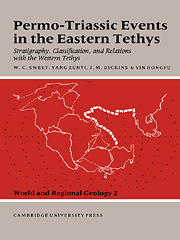 Permo-Triassic Events in the Eastern Tethys
Permo-Triassic Events in the Eastern Tethys Published online by Cambridge University Press: 12 October 2009
Introduction
Transcaucasia and Primorye are regions in which problems of Permian and Triassic biostratigraphy were studied long ago. The first description of Late Permian invertebrates from Transcaucasia was made by Abich (1878) who considered them to be Early Carboniferous. After finding some fossils in his collection that were later described by Stoyanow (1910) as Paratirolites, Mojsisovics (1879) erroneously correlated the appropriate Transcaucasian sediments with the Lower Triassic Tirolites beds in the Alps. After the discovery of the Otoceras beds in the Himalaya (Griesbach, 1880) new possibilities appeared for correlation of the Permo-Triassic boundary beds in Transcaucasia.
Griesbach (1880) considered the Otoceras beds to be earliest Triassic. Later he began to think that they might be intermediate in age between Permian and Triassic. The ammonoids described by Abich and later named Araxoceras, Prototoceras, and Vescotoceras by Spath (1930) and Ruzhencev (1959, 1962), were considered by Griesbach to be close to, or identical with Otoceras. However, on the basis of suture-line data, Mojsisovics (1892) determined ‘ Otoceras’ from Transcaucasia to be more primitive than Otoceras from the Himalayas. In Mojsisovics' opinion, the Transcaucasian forms seemed to be Permian and the Himalayan forms Triassic. Later this idea came to be generally accepted, but it was also discovered that the Transcaucasian rocks (Dzhulfian Stage) with otoceratids lie below Dorashamian sediments (Rostovcev & Azaryan, 1974), which form the uppermost part of the Permian. In southeast China the Changxing Formation occupies this position (Chao, 1965).
Permian ammonoids are not diverse in Primorye. The first Permian ammonoid (Daubichites) was discovered in South Primorye in 1961 (Popov, 1963). Then, some Late Permian ammonoids were described by Ruzhencev (1976), Pavlov, and Zakharov (Zakharov & Pavlov, 1986a,b).
To save this book to your Kindle, first ensure [email protected] is added to your Approved Personal Document E-mail List under your Personal Document Settings on the Manage Your Content and Devices page of your Amazon account. Then enter the ‘name’ part of your Kindle email address below. Find out more about saving to your Kindle.
Note you can select to save to either the @free.kindle.com or @kindle.com variations. ‘@free.kindle.com’ emails are free but can only be saved to your device when it is connected to wi-fi. ‘@kindle.com’ emails can be delivered even when you are not connected to wi-fi, but note that service fees apply.
Find out more about the Kindle Personal Document Service.
To save content items to your account, please confirm that you agree to abide by our usage policies. If this is the first time you use this feature, you will be asked to authorise Cambridge Core to connect with your account. Find out more about saving content to Dropbox.
To save content items to your account, please confirm that you agree to abide by our usage policies. If this is the first time you use this feature, you will be asked to authorise Cambridge Core to connect with your account. Find out more about saving content to Google Drive.